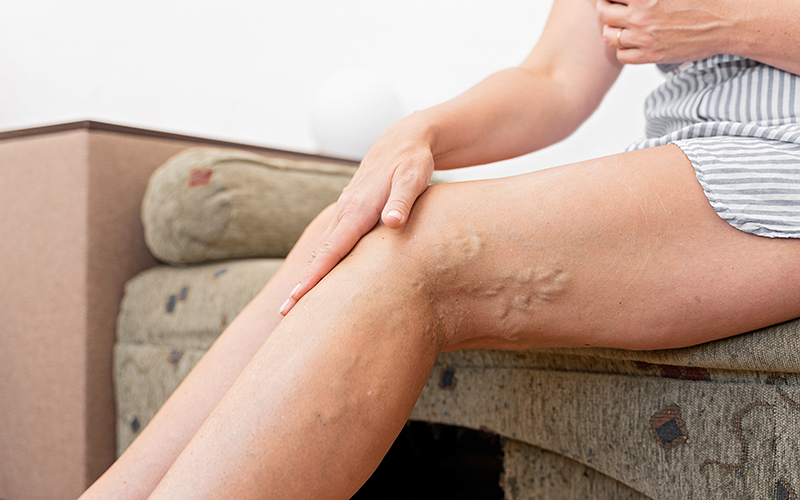
In just five-minutes, Vascular and Endovascular Surgeon John “Jack” McCallum, MD, shares his top three tips for preventing varicose veins, what the symptoms are and how to treat them. Find out when varicose veins cross the line from just being cosmetic to a condition that should be medically treated. Watch the video and read the transcript below, with blow flow diagram.
0:14 | What are varicose veins?
Varicose veins are abnormal veins that are near the surface of the skin. They often appear as bulges and may look blue in color. Another condition that’s related to varicose veins is telangiectasias, also known as spider veins. These are tiny clusters of red or blue veins just below the surface of the skin. Together, varicose veins and spider veins are considered part of chronic venous disease, which includes several other conditions as well.
0:46 | What are the symptoms of varicose veins?
For many patients, varicose veins have no symptoms. For some, varicose veins can be painful, sometimes described as aching or like a muscle cramp. For others, varicose veins can lead to discolored skin, both around the varicose veins, and sometimes at the ankle. In severe cases, varicose veins can be related to wounds or ulcers forming, or with blood clots within the varicose veins.
1:19 | What causes varicose veins?
For many patients, varicose veins are caused by sitting or standing for long periods of time. For others, varicose veins are caused by a related condition called venous reflux—this is when blood flows the wrong direction through an associated vein, usually a saphenous vein. Below is a description of what is happening in the body during venous reflux.
- Arteries: As the heart pumps blood, it uses arteries to deliver blood to the arms and legs.
- Veins: As we move our arms and legs, our veins carry the blood back to our heart.
- Valves: When we aren’t moving our arms and legs often enough, we have valves to help maintain the normal flow of blood to the heart. In venous reflex, these valves become damaged and instead of helping the blood flow, it begins to build up.

2:12 | Who was at risk for having varicose veins?
Anyone is at risk for having varicose veins; it is very common. Other factors that increase a person’s risk include those who have been pregnant, are overweight, smoke cigarettes, and those with a history of blood clots or venous reflux that has damaged their valves. Risk also increases with age.
2:42 | How are varicose veins diagnosed?
Varicose veins are usually diagnosed easily because we can see them. They are often seen by patients themselves or by their primary care doctors. The underlying cause of varicose veins, which is often venous reflux, is commonly diagnosed by an ultrasound.
3:01 | How are varicose veins treated?
For many patients, their best treatment includes exercise, weight loss, elevating the limb, and wearing a compression garment on the affected limb, such as a compression stocking. If patients still have symptoms after trying the above measures, there are a number of options:
- Phlebectomy: Surgically removing the cluster of varicose veins.
- Sclerotherapy: Injecting a medicine into the cluster of veins to cause them to scar over and close.
- Closing the saphenous vein: The saphenous vein, which runs along the length of your legs, is also known as a truncal vein. When a cluster of varicose veins leads to reflux in the saphenous vein, we recommend closing it to release pressure in the varicose veins. This can be done in two ways.
- Radio frequency ablation—This process uses heat to cause the vein to close up.
- VenaSeal—This process uses glue to close the vein.
4:16 | What are possible complications of varicose veins?
Most patient have little to no symptoms throughout their lives, while some patients find their varicose veins become more painful over the course of their lives. Varicose veins may often grow in size as we spend more time standing. Other complications include blood clots forming within the clusters of varicose veins, and venous wounds, such as ulcers or open sores at the ankle.
4:47 | Under what circumstances does treatment for varicose veins become medically necessary?
Surgery is often recommended when a patient’s varicose veins are painful. Serious complications can also result in surgery, including repeated blood clots within the varicose veins and skin changes at the ankle, such as ulcers or open sores.
5:15 | What can people do to prevent varicose veins?
To prevent varicose veins, people should maintain a healthy weight, remain active throughout the day, and avoid smoking cigarettes.
If you are concerned about varicose veins or other vascular issues, please visit valleymed.org for more information about our vascular care or call for an appointment at Valley’s Vascular Surgery Clinic at 425.690.3496.


Is compression socks help.
Thank you for reading our blog! We reached out to Dr. McCallum with your question asking if compression socks help varicose veins. He said “Yes. Compression socks do help and are often all that patients need to manage their varicose veins. Compression socks won’t make the veins go away or “cure” the problem, but can be used to manage the symptoms of varicose veins very effectively.”